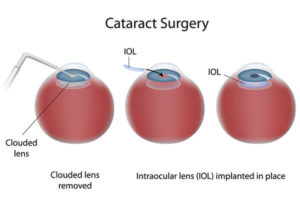Have you recently found out you have cataracts? You may have many questions about this diagnosis, including what they are, when you’ll need cataract surgery, what to expect from it, and more. Our expert ophthalmologists at Eye Physicians are here for all your eye care needs, including when it’s time to have cataract surgery.
What is a Cataract?
Cataracts occur when the natural lens in the eye becomes cloudy due to the build-up of proteins clumping together. When this happens, you may notice that your vision seems foggy, impaired, or even like looking through a dirty window.
Cataracts gradually develop over time, meaning you may have them in your forties or fifties and not realize it at first. When they are still in the early stages, you may not notice any changes to your vision.
However, when cataracts continue developing, you may notice that it becomes much more challenging to do things you love, like cooking, hiking, sewing, or other hobbies, due to your reduced ability to see. This is an excellent time to consider having cataract surgery for many people.
What are the Symptoms of a Cataract?

If you have a cataract, you may not know it at first. Common symptoms include:
- Blurry vision
- Glare
- Seeing halos around sources of light while driving at night, especially streetlights or from oncoming traffic
- Experiencing double vision in only one eye
- Seeing things that you know should be white as muddier or brown in color
- Injuring yourself more due to your impaired vision
- Finding that you need more frequent prescription changes for your glasses or contact lenses
- Seeing colors as more muted or less vibrant than they used to be
- Needing more light when you’re completing fine-focus tasks
- Experiencing an increase in light sensitivity
If these signs seem familiar to you, it may be time to see your eye doctor. Even if you don’t have cataracts, they can rule out other eye conditions and determine the cause of your vision issues.
What is Cataract Surgery?

Cataract surgery is the only way to treat cataracts. Although you can increase your prescription, use more light to see, or try other methods, these are temporary.
Cataract surgery is when you remove your natural lens from the eye. You need to have a lens in your eye to see clearly, so it’s replaced with an artificial lens, known as an intraocular lens.
What is an Intraocular Lens?
An intraocular lens (IOL) is an artificial lens that replaces the cloudy natural lens during cataract surgery. IOLs are one of the most crucial components of cataract surgery. With modern technology, you have many options that will help meet your visual needs.
Your eye doctor at Eye Physicians will recommend the best IOL for you based on your lifestyle, visual needs, and goals after cataract surgery. Consider whether you want to wear glasses after cataract surgery. If you live an active lifestyle, there are many options to help you complete those tasks.
What Can I Expect During Cataract Surgery?
Cataract surgery is an outpatient procedure, meaning you can go home the same day. The surgery takes about 20 minutes to complete but you will be at the surgery location for approximately 3 hours.
You’ll start by receiving numbing eye drops during the procedure to ensure you don’t feel any pain. We’ll also give you a mild oral or IV sedation if you’re nervous. The eye is dilated after the numbing eye drops cover the surface of the eye.
We perform laser cataract surgery at Eye Physicians using the state-of-the-art LenSx femtosecond laser. The laser allows your cataract surgeon to create small incisions with the utmost precision at the front of the eye.
These openings create an opening in the capsule to access the cataract. After accessing the cataract, phacoemulsification is used to dissolve the cataract and natural lens into tiny pieces before gently suctioning it out.
After removing the natural lens, the intraocular lens is gently placed. There are no stitches needed, thanks to a self-sealing technique. The technique places the incision into the cornea, next to the sclera. After recovery, you can have a trusted friend or family member drive you home.
As the most performed medical procedure, cataract surgery has very few complications and side effects, although they are possible. Many patients start seeing visual improvement almost immediately, though individual patient results vary. Your surgeon will discuss what to expect during your cataract consultation.
The eye is dilated for surgery and your vision will be blurry on the day of surgery.
Cataract Surgery Technology at Eye Physicians
At Eye Physicians, we believe in the importance of offering our cataract patients modern and revolutionary technology. That’s why we use the LenSx femtosecond laser and ORA technology to perform laser-assisted cataract surgery.
Using the LenSx laser includes advantages like:
- Fragmenting the lens means your surgeon doesn’t need to use as much ultrasound energy while removing it, resulting in a faster recovery after having laser-assisted cataract surgery
- The ability to correct small amounts of astigmatism by reshaping the cornea with the laser
- More precise incisions in the cornea give your surgeon greater control during laser-assisted cataract surgery
- Better access to the lens capsule means more exact placement when putting in IOLs and better vision after the procedure
- It’s easier to extract your cataract by breaking it into smaller pieces before softening it, leading to faster removal
IOLs Available at Eye Physicians
Intraocular lenses are constantly changing and evolving as technology advances. At Eye Physicians, you’ll find a variety of premium lens options, including:
Light Adjustable Lens

The Light Adjustable Lens (LAL) is the first intraocular lens of its kind, as it offers patients the ability to customize their vision after cataract surgery. The lens uses special UV light treatment procedures to optimize your eyesight after your eyes heal.
The Light Adjustable Lens also offers the ability to correct astigmatism. During subsequent appointments, you’ll be able to optimize and preview what your vision will look like before locking it into place.
Eyhance

The Eyhance is technically a monofocal IOL. Instead of having one uniform lens, Eyhance has one refractive power set on the edges of the lens, allowing it to transition to a different refractive power in the middle of the lens.
Patients experience improved distance vision when looking at things far away and intermediate distances.
PanOptix

The PanOptix is the only FDA-approved trifocal lens. As a trifocal IOL, it provides excellent vision up close, far away, and when looking at things at a middle distance.
You can see clearly in all lighting conditions, even when dim or bright. Most patients find that they no longer need to rely on glasses nearly as much after choosing the PanOptix.
A trifocal IOL can be highly beneficial if you spend a lot of time on the computer, allowing you to see with sharp, vibrant vision at all times.
Vivity

The Vivity IOL is the first and only non-diffractive extended depth of focus (EDOF) IOL available. Thanks to its use of proprietary X-WAVE Technology, Vivity allows patients to see extremely well at intermediate distances, while still providing functional up-close vision.
X-WAVE Technology stretches and shifts light instead of splitting it, increasing the focal range of patients. Patients can see more clearly at multiple distances with fewer side effects like glare, halos, and starbursts.
Synergy

The Synergy IOL is a premium lens that corrects presbyopia. Thanks to its continued depth of focus, it also provides the broadest range of vision available for any IOL.
There’s no division between the ranges of vision on the lens, meaning you can see clearly when looking at something nearby, far away, or anything in between, with no reduction in clarity of vision. Things are exceptionally sharp if you need to see something up close. It also provides excellent contrast in low lighting, which may eliminate the need for glasses after cataract removal.
Toric Lenses

If you have astigmatism, your eye is closer to the shape of a football rather than a basketball. If the eye is misshapen or irregular, it disrupts your vision.
During cataract surgery, you can have astigmatism corrected while having cataracts removed. Many premium lenses offer toric models, including Eyhance, PanOptix, Vivity, and Synergy IOLs.
Do you think it may be time to have cataract surgery? Schedule your cataract consultation at Eye Physicians in Columbus, Nebraska today! Isn’t it time to stop letting your vision rule your life?







